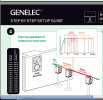Hello!
Inspired by a Neumann advertising video in which absorbers from "greenacoustics" are used, I am considering using them to improve my listening room. At the moment I'm still using old, temporary Basotect absorbers. I would like to replace them with a good solution. It is important to me that it is harmless to health, since I sleep and work in the room and often spend about 20 hours a day there. They are filled with Caruso ISO Bond. This is how they look:
 And in the video:
And in the video:

Here are the measurements of the three absorber types, that "greenacoustics" offers, overlaid - DE-BASS is a plate resonator tuned to 80Hz, DE-MITTER ist a perforated plate absorber tuned to 160Hz, BB-STANDARD is a porous absorber (10cm Caruso ISO Bond). As you can see, according to their published measurements they seemingly work well together:

Here I have overlaid the measurement curves of the absorber types plus the isobar diagram of the KH310 and my current frequency response. I don´t know how well you can see it, but maybe you can see i have still problems with a dip around 80Hz (despite using 2 subs and 2 AVAAs already), and the FR is pretty uneven up to 1000Hz. From 600Hz downwards, the directivity of the KH310 starts getting more wide.

In the descriptions from Greenacoustics and also in the Neumann video, it is always recommended that the standard absorber should be at the top and the DE-MITTER or DE-BASS at the bottom.
I now have the following questions:
- Is it possible that the 80Hz-resonator helps with my 80Hz-dip?
- What should i place directly behind the speakers? The DE-MITTER or the DE-STANDARD? Beware that at the moment i already use 10cm Basotect behind the speakers - i guess there will be not much difference between 10cm ISO Bond (10000kpa) and 10cm Basotect (14000kpa).
- Will the DE-MITTER still work well if it is placed below the speakers (like in the Neumann-video)?
Right now my temporary setup looks like that:

Inspired by a Neumann advertising video in which absorbers from "greenacoustics" are used, I am considering using them to improve my listening room. At the moment I'm still using old, temporary Basotect absorbers. I would like to replace them with a good solution. It is important to me that it is harmless to health, since I sleep and work in the room and often spend about 20 hours a day there. They are filled with Caruso ISO Bond. This is how they look:
Here are the measurements of the three absorber types, that "greenacoustics" offers, overlaid - DE-BASS is a plate resonator tuned to 80Hz, DE-MITTER ist a perforated plate absorber tuned to 160Hz, BB-STANDARD is a porous absorber (10cm Caruso ISO Bond). As you can see, according to their published measurements they seemingly work well together:
Here I have overlaid the measurement curves of the absorber types plus the isobar diagram of the KH310 and my current frequency response. I don´t know how well you can see it, but maybe you can see i have still problems with a dip around 80Hz (despite using 2 subs and 2 AVAAs already), and the FR is pretty uneven up to 1000Hz. From 600Hz downwards, the directivity of the KH310 starts getting more wide.
In the descriptions from Greenacoustics and also in the Neumann video, it is always recommended that the standard absorber should be at the top and the DE-MITTER or DE-BASS at the bottom.
I now have the following questions:
- Is it possible that the 80Hz-resonator helps with my 80Hz-dip?
- What should i place directly behind the speakers? The DE-MITTER or the DE-STANDARD? Beware that at the moment i already use 10cm Basotect behind the speakers - i guess there will be not much difference between 10cm ISO Bond (10000kpa) and 10cm Basotect (14000kpa).
- Will the DE-MITTER still work well if it is placed below the speakers (like in the Neumann-video)?
Right now my temporary setup looks like that:
Last edited:


